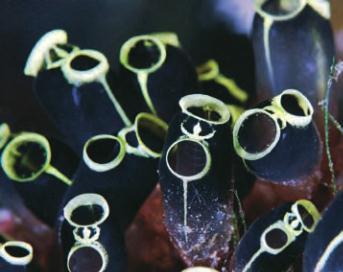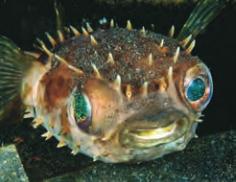Basic HTML Version



80
|
WINTER 2012
Martek Biosciences Corp. is studying
another algae derivative — an unusual
fatty acid similar to that in the retina
and the brain’s gray matter. Its initial
commercial use will be as an additive for
infant formula. Marine pharmacologists
have also extracted alginic acid from
algae and seaweeds and have made salts
(alginates) with a variety of medicinal
properties. Some help tablets disintegrate
more rapidly in the stomach. Others form
the basis of anti-clotting drugs (sulfated
lamarin) and of preparations used to
help control bleeding (calcium alginate).
Sodium alginate has the exciting ability to
reduce humans’ absorption of radioactive
strontium, the most dangerous byproduct
of radiation fallout, by about 90 percent.
Pufferfish
A delicacy in Japan, where it is called
“fugu,” the pufferfish is another carrier
of a potent marine neurotoxin. Chefs
must undergo extensive training to learn
to prepare it safely. Pufferfish contain
tetrodotoxin, a powerful blocking agent
that acts on muscles, sensory nerves and
motor nerves and is 275 times more
toxic than cyanide. The skin, gonads and
viscera of the pufferfish are so deadly
to humans that death can occur within
15 minutes of ingestion. Oddly, this
same deadly toxin is also commercially
available in an antispasmodic drug for
people with seizure disorders and to help
relieve the agony of terminal cancer.
Cone snails
Cone snails, beautifully patterned
creatures that most divers know not to
touch, fend off their would-be attackers
by ejecting a venomous tooth that
penetrates the predator’s skin with
a lethal toxin. The toxin is a muscle
relaxant that causes breathing to slow
down and potentially stop. Scientists
at the University of the Philippines
discovered that one protein in the
toxin of the snail Conus geographus
interfered with nerve function in such a
way as to make it a potential painkiller.
Derivatives of this toxin are being used
for patients whose muscles are in a state
of convulsion or who have nerve damage.
Filipino pharmacologists have also
discovered a cone-snail poison that
is 1,000 times more powerful than
morphine in treating certain kinds of
chronic pain. The snail-derived drug,
Prialt
™
, was developed by Elan Corp.,
which later sold it to Azur Pharma. Prialt
impairs nerve transmission in the spinal
cord and blocks certain pain signals from
reaching the brain. Scientists predict that
many more cone-snail toxins will be drug
leads since there are 500 known species
of this animal.
hagfish
The hagfish is an interesting creature
in that it has three hearts, only one
of which is controlled by direct nerve
connections to the brain. A chemical,
eptatretin, stimulates and coordinates
the beating of the other two. When mice
with damaged cardiac nerves are given
eptatretin, normal heartbeat is restored.
Researchers are studying the feasibility of
using eptatretin instead of electronically
monitored pacemakers for humans with
impaired or irregular heartbeats.
Mollusks
While many mollusks such as clams,
oysters and scallops are most often
thought of as menu items, some mollusks
contain extracts that make for effective
antiviral drugs. These have been shown
to protect laboratory mice infected with
influenza and polio virus. An extract from
the quahog clam helps shrink tumors, and
an extract from the New Zealand green-
lipped mussel is being widely sold for its
supposed beneficial effect on arthritic
conditions. Even the lowly sea slug has
its assets — scientists studying it believe
its nervous system holds clues to better
understanding bipolar disorder.
Corals
Stony corals build limestone structures
that are in some ways similar to human
skeletons. After undergoing chemical
modification, coral has been used
successfully in bone grafts, primarily of
the face and skull. Plexaura homomalla,
a gorgonian, is a particular coral
species that shows great promise. The
outer layers of these corals contain
prostaglandins — chemicals that
stimulate many physiological functions
in humans such as contraction of the
womb during labor. Plexaura homomalla
has the highest known concentration of
prostaglandins in nature.
A species of sea whip coral,
Pseudopterogorgia elisabethae, produces
compounds called pseudopterosins,
which have demonstrated effectiveness as
anti-inflammatories and wound healers.
They are able to moderate the activity of
a key enzyme involved in inflammation,
and they can do so more effectively
than hydrocortisone. Pseudopterosins
might one day be integral components
in drugs used to treat inflammatory
conditions such as psoriasis, sunburn
and arthritis. Pharmacologists at
Scripps Institute and the University of
California Santa Barbara hold the patent
on pseudopterosin drugs and have
licensed a biotech company, Nereus
Pharmaceuticals, to investigate their
capabilities. Pseudopterosins’ ability to
protect a skin protein called elastin has
From left: Cone snail
(Conus sp.); long-
spine balloonfish
(Diodon holocanthus);
tunicates, also
known as sea squirts
(Ascidiacea sp.)
Opposite: Variable
thorny oyster
(Spondylus varians)
P HO T O S T H I S P A G E : G E R I MUR P H Y
76-81_Pharmacy_Winter2012.indd 80
12/21/11

